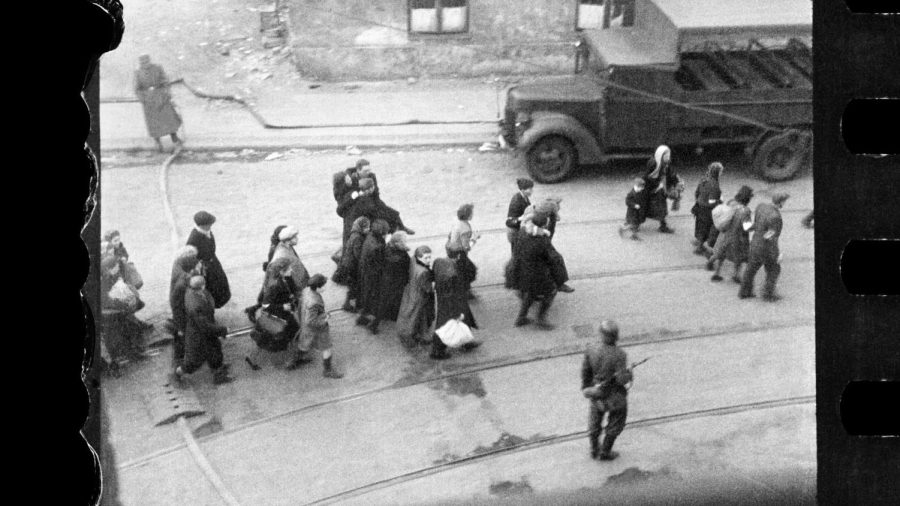The symmetry of storytelling can be an amazing thing, with the right story
Jews being led to Umschlagplatz; photo taken from a window of St Zofia Hospital at the corner of Żelazna and Nowolipie Streets, most likely (to be confirmed) overlooking Nowolipie Street; author’s comment noted after the war at the back of the print held in the USHMM archive in Washington, DC: ”Scenes from the evacuation of the ghetto, ca 20 April 1943” Photo: Z. L. Grzywaczewski / from the family archive of Maciej Grzywaczewski, son of Leszek Grzywaczewski / scan of the negative: POLIN Museum, Archaeology of Photography Foundation
Published April 20, 2023
We marked Yom HaShoa, Holocaust Memorial Day, on April 17-18.
I don’t remember the details of the story, but I do remember some of the names. He was a survivor of the Warsaw Ghetto. We met him on sabbatical to Israel, mid-’90s. I was studying music by night and, by day, we sat in an Ulpan, a language class.
The organizers of the Ulpan brought in a man to speak to us, to tell his story and to exercise our Hebrew. The man was retired and spent his time telling his story to classes and other gatherings.
He had been imprisoned inside the ghetto in Warsaw. There was a man outside the ghetto walls who would risk danger and toss supplies over the wall at night. They had not met, and there was no exchange of names or identities. The man telling the story assumed he was a sympathetic Pole, and although he was suspicious, there was enough of this exchange that the teller of the tale developed trust.
The man inside the ghetto had a box with heirlooms of his family and other valuables that his mother had entrusted him with. He was certain that the ghetto was going to end in destruction, so he took a chance and one night flung the box over the wall to his co-conspirator on the other side with a note to hold it for him in the event that he survived. That they would find each other seemed like an unlikely scenario.
The teller of the tale survived World War II and after another series of dramatic chapters he landed in Israel and made a life there. Part of his life became the telling of his story to classrooms mostly of kids who had no firsthand knowledge of the horrors he had lived through. I met him more than 50 years after the war in which his story took place.
His story was layered. He told it in the chapters that developed after he thought the story had been closed. One day, he was telling his story to a group of adults in Jerusalem. It was decades after the end of the war, and someone in the rear of the room interrupted with, “I know this story.”
“I have heard this story,” that person said, “but I heard it told from the other side of the wall. … I think the person who received your box lives in Tel Aviv, his name is Lieberman and he is a foreman in a factory there.”
“Cannot be,” the teller of the tale said. “This man was not a Jew.”
“Was he gingi” (fair skinned, red-headed)?
“Yes.”
“He is a Jew, he survived the war masquerading as a Pole, but his name is Lieberman and he runs a factory in Tel Aviv. I have heard him tell his side of the story.”
The teller of the tale left the room, made a phone call, jumped in his car and headed for Tel Aviv.
In Lieberman’s office, they found each other over a desk and Lieberman filled in his part of the story.
“I have kept this here with me all these years in case you had survived, just for this moment,” he said, reaching under his desk and for the box with the teller’s possessions in it.
I love this story not only for the few details I remember but because of the symmetry of stories that it represents. All story. When you are entrusted with stories, or when you write stories, or when you tell stories, you come to know that stories have an organic sense not unlike nature, like a tree of stories.
Sometimes, the story throws a branch here, a shoot there, the story surprises in that it has an organ symmetry. It has a shape, like the symmetry of a tree. A wildness that is not random, also not perpendicular.
When you are entrusted with such stories, you tell them and you become open to the storytelling. The story may be telling you in the sense that stories grow and move and change and throw a branch here another shoot there. These are stories about people, wild unpredictable and with a symmetry of their own, and I have had many stories entrusted to me that have grown in just this way.
I had been entrusted with this story about 25 years ago. In 2020, for the first time, I told it.
What to do with such stories? Tell them.















